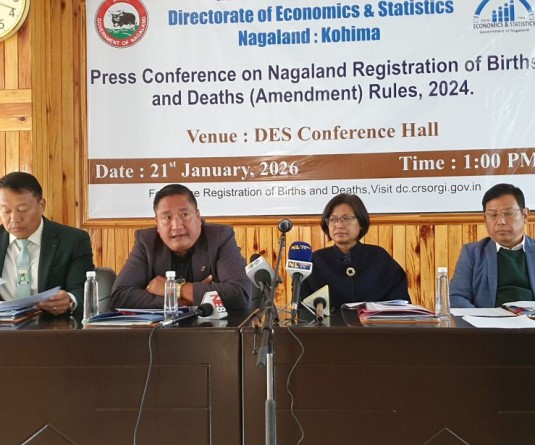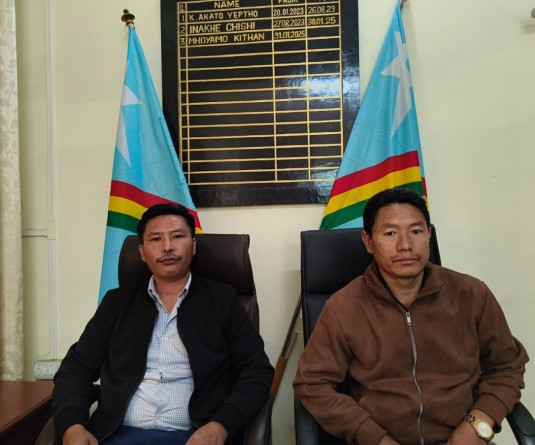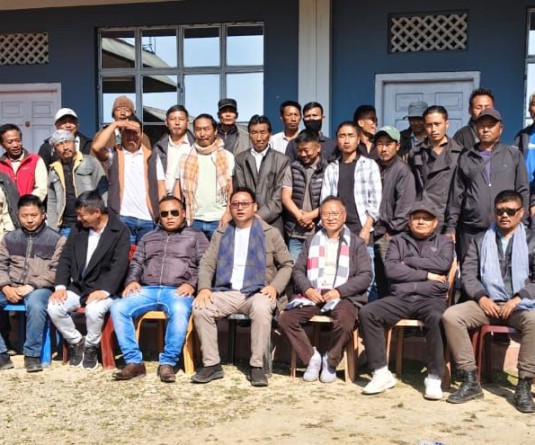
Naga People’s Movement for Human Rights holds 23rd Morung Dialogue
Dimapur, September 28 (MExN): Naga People’s Movement for Human Rights (NPMHR) 23rd Morung Dialogue on the topic ‘Weaving Self-Determination through cultural heritage’ was held on September 24 with Dr Nesatalu Hiese, Scientist D, Patent Information Centre, Nagaland Science & Technology Council and Mo Naga, Traditional Artist and Designer as the speakers.
The 23rd Morung Dialogue, according to a press release from NPMHR, was initiated to discuss the important role that traditional handicrafts and art play in sustaining indigenous communities; challenges faced by artisans and communities due to cultural appropriation, modern production and property right systems; and the responses that can be taken to ensure meaningful preservation of cultures, allow flourishing of innovation in art and design, and give artisans and communities their due earnings for the creation of products that are the result of the labour of current and prior generations.
Identity and self-determination
Chair of the dialogue, Dr Achan Mungleng, anthropologist, independent researcher, consultant, and a trainer began by discussing the connection between identity and self-determination, how the idea of self-determination becomes fulfilling only if there is an identity to begin with, and the importance therefore, of preserving and carrying forward external cultural markers of identity like our traditional motifs and patterns in textiles, attires and tattoos.
Dr Achan noted that as a trainer and researcher closely involved with this issue, she is of the opinion that our communities are yet to recognize and give this issue its due importance due to socially constructed gendered-division of activities in our traditional patriarchal set-up where weaving was exclusively assigned to women, while the stories and knowledge behind the motifs and patterns being weaved was considered the domain of men.
She also pointed out that despite the encouragement/pressure from organizations like the Tribal Cooperative Marketing Development Federation of India Limited (TRIFED), we have members of indigenous communities who are against registration for Geographical Indicator tags for reasons such as: it does not provide adequate protection to the indigenous cultural products and expressions; it is a threat to our cultural maintenance; or because it is designed to foster commercialization.
Decolonize ways of thinking
Mo Naga underlined the ‘need to decolonize our ways of thinking, because we have been conditioned to believe that expressions of our creativity can only be categorized as art or culture and not as design. This assumes an implied simplicity; in that they are directly copied from nature without thought.’
“In fact, like other cultures, the products and artefacts made by us also factor elements of design, which requires inspiration, functionality and thought,” he said. “We need to go beyond merely taking pride in staking ownership over our cultural products and artefacts, without understanding what it is that we are claiming ownership of.” In order to do this, he said, “We would have to learn how to see through the eyes of our forebears.”
He cautioned that our creativity would be threatened if the tribes were to too jealously lay claim to their symbols. He also said that these were products not of individual efforts, but that of the community connected across time. Mere imitation was therefore not possible in such a situation, he said, citing the great pride each tribe placed on the distinctive appearances and diversity of their mekhalas, shawls and tattoos.
He stated the dangers lying in other directions, such as cultural appropriation by non-indigenous producers and designers, or by our own people who have lost awareness of the meanings that lay behind the symbols of our cultural artefacts, which was leading to them blindly imitating motifs without regard for their significance.
Cultural appropriation, Intellectual Property Rights
Dr Nesatulu delved deeper into how cultural appropriation was occurring and displayed several cases of how fashion designers have laid claim to rights over our traditional motifs, methods of textile production, and even the associated words in tribal dialects used to describe these. Products based on these designs and often sacred methods are now being sold, on the one hand, with the symbols distorted and their meanings lost, without any regard to the deep significance many of the symbols hold for the communities they belong to. And on the other, without compensating the communities whom have created them in the first place, and were gracious enough to share their traditions and knowledge not aware that these would be copyrighted.
She segued into the importance that Intellectual Property Rights played in the Naga context, and encouraged Nagas to make use of current mechanisms for property rights disputes like Geographical Indication tags, that would prevent the worst of the excesses observed. This process required documentation such as those related to the proof of origin, to be done by the respective tribes. However, this has not been accomplished yet despite attempts to do so, e.g. in the case of traditional shawls of the Ao, Angami and Sema tribes, due to which GI tags have been refused as of now.
She said that this was partly due to the ignorance of the National Institute of Fashion Technology, whose help was sought in the matter, which wrongly stated the same descriptions for the shawls of the three tribes in the application. So it would require groundwork from the individual tribes to take it upon themselves to hold discussions with villagers, elders and experts; and ascertain cultural, historical facts, uniqueness of methods, motifs etc. for documentation. This was also in our best interests given the collective nature of the resources in question, because it is only with discussions and community consensus that we would be able to decide which patterns, motifs would be allowed for commercialization, and which ought to be retained by the community due to the significance they hold, and prevented from being commercialized.






